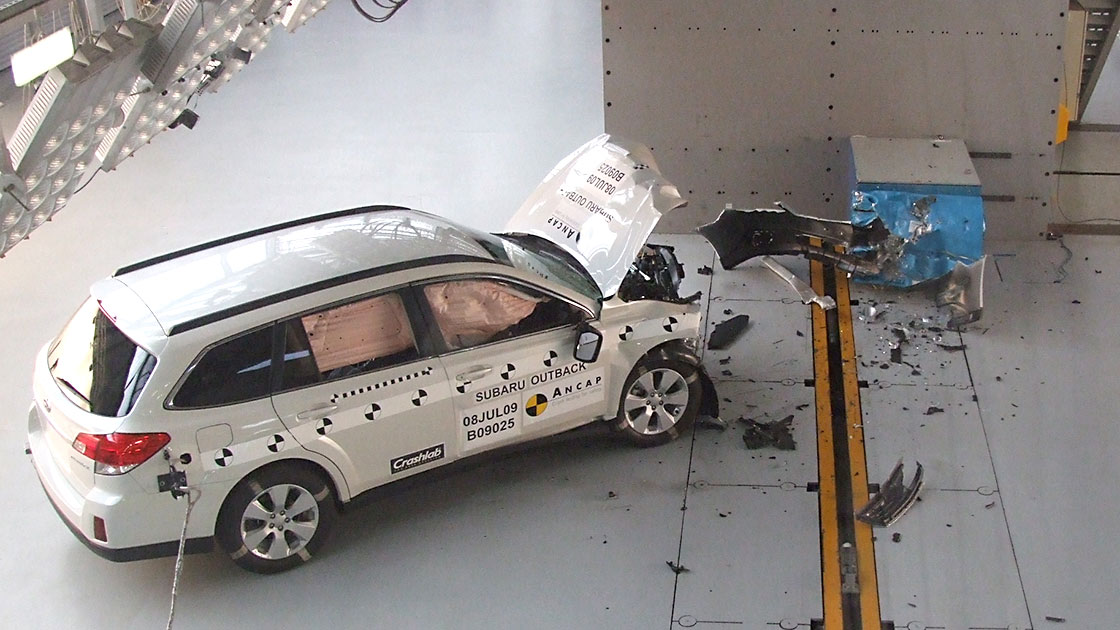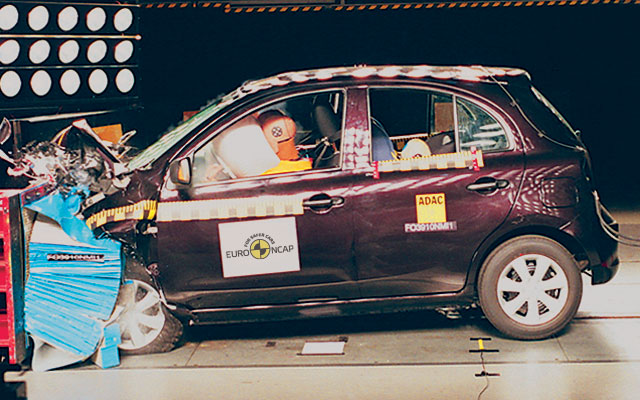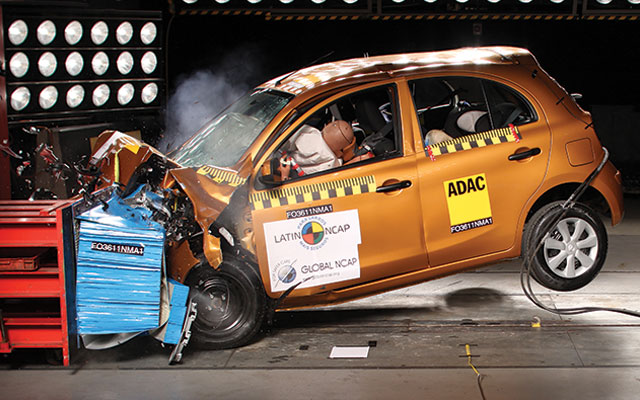Safety gains aren't global: Some regions lag
June 27, 2013

Buy a new passenger vehicle in the U.S., European Union, Australia or other developed country and one can expect a relatively high level of safety, but that's not the case in emerging markets. About a third of new vehicles sold worldwide fall short of the basic frontal crash protection provided by models sold in these high-income regions.
As the focus in the United States shifts to technology to prevent crashes altogether and even replace drivers with autonomous vehicles, some developing nations are just beginning to address the fundamental safety protections that are standard here.
Missing from many vehicles built for the burgeoning middle class in markets such as Argentina, Brazil, Indonesia, Malaysia and Mexico are strong occupant compartments that won't collapse in a crash and crumple zones to absorb crash energy. Frontal airbags for the driver and front passenger — standard on U.S. vehicles since 1999 — are typically optional equipment.
Without strong government safety regulations, automakers, including the big U.S., Japanese and European manufacturers, can sell cars in emerging markets that aren't as safe as ones they sell in industrialized countries. At the same time, consumers may not realize that their vehicles won't protect them in crashes as well as the same or similar models sold in other parts of the world because their countries don't have crash test programs for consumer information.
In the U.S., selling vehicles without basic safety equipment would be unthinkable today. But not so long ago, many automakers resisted efforts by IIHS and other groups to get airbags and other safety improvements in cars. By the late 1980s, however, manufacturers began to tout safety features as a way to distinguish themselves from competitors. The switch was due in large part to the National Highway Traffic Safety Administration's (NHTSA) pioneering New Car Assessment Program, which launched in 1978 and helped give rise to the safety marketplace that took root in the 1980s. In turn, U.S. NCAP inspired other crash test programs in Australia, Europe and Japan. IIHS also rates the safety of passenger vehicles in the U.S.
Global NCAP and insurance research centers
Looking to build on this success, the Global New Car Assessment Programme aims to help create safety marketplaces in underserved countries. The London-based organization officially was launched during the June 2011 Enhanced Safety of Vehicles (ESV) conference in Washington, D.C. The nonprofit is primarily funded by the FIA Foundation for the Automobile and Society.
IIHS and NHTSA are Global NCAP members, along with ASEAN NCAP, the Australasian New Car Assessment Program (ANCAP), China New Car Assessment Program (C-NCAP), the European New Car Assessment Programme (Euro NCAP), Japan New Car Assessment Program (JNCAP), Korean New Car Assessment Program and Latin NCAP.
Global NCAP offers technical guidance and financial support to expanding New Car Assessment Programs as part of the United Nations' Decade of Action for Road Safety. The goal is to halve the death and injury toll on roads worldwide by 2020. The newest NCAP programs are in Latin America and Southeast Asia.
"Global NCAP is creating the momentum and participation that will help to turn the U.N. Decade of Action from words into action," David Ward, secretary-general of Global NCAP, said at the organization's second annual meeting May 30 in Seoul, held in tandem with the 2013 ESV conference.
Global NCAP members adopted a declaration that encourages consumers to choose the highest-rated vehicles when possible and calls on manufacturers to "make a voluntary commitment to set a floor of minimum safety standards for the vehicles they produce worldwide."
About 20 million of the 60 million new cars sold worldwide in 2011 didn't comply with the United Nations' Regulation 94 for frontal crash protection, Global NCAP estimates.
"This is astounding in a period of extraordinary globalization and growth for the auto industry," said Ward, who also is director-general of the FIA Foundation, in an address at ESV.
The majority of new vehicles sold in the U.S., Europe and Australia earn top crash test ratings. For NCAP-evaluated vehicles, that means at least four stars out of a possible five to indicate how well they protect occupants in front, side and rollover crashes. Besides points for crashworthiness, some NCAPs also award credit for pedestrian protection, safety belt reminders, speed limiters, electronic stability control and other crash avoidance features.
Instead of stars, IIHS rates vehicles good, acceptable, marginal or poor based on how well they protect people in the most common types of crashes: moderate overlap front, small overlap front, side impact, rollover and rear crashes. The top performers qualify for the Institute's highest safety award, Top Safety Pick++. IIHS has been rating vehicles for consumer information since 1996 to encourage automakers to build models that protect people in a wider range of crash configurations than government tests address.
In Australia, ANCAP published its first crash test results in 1993. Euro NCAP released its first ratings in 1997. JNCAP was established in 1996, Korea's NCAP launched in 1999, and China's began in 2006.
The Research Council for Automobile Repairs, or RCAR, is an international group working to globalize best practices in vehicle safety and repairability. The 25 member groups of RCAR include automotive research centers and insurers in 19 countries. IIHS, State Farm and Allstate's Tech-Cor Inc. in the U.S. are among them.
RCAR researches ways to reduce vehicle damage in crashes and tackles such issues as vehicle repair procedures and processes, safety features and new technology, all of which affect the cost of insurance and repairs. RCAR has worked on global standards on whiplash injuries and vehicle damage in low-speed crashes, among others. Many member groups are collaborating with NCAP organizations to develop test procedures for new crash avoidance technology.
Latin America and the Caribbean
While top-rated vehicles are available in most size classes and price points in countries with consumer safety information programs, the story is different in Latin America and the Caribbean. Latin NCAP tests show that many vehicles don't provide adequate protection in frontal crashes. What's more, some don't measure up to the good structural performance of similar models produced by the same manufacturers for sale in Europe.
The rapidly growing Latin American automobile market has among the world's highest fatality rate from road crashes. The World Health Organization estimates that in 2010 there were 23 road deaths per 100,000 people in Brazil and 15 road deaths per 100,000 people in Mexico. This compares with WHO's estimated 11 road deaths per capita in the U.S., six per capita in Australia and four per capita in the United Kingdom.
Launched in 2010 as a three-year pilot project, Uruguay-based Latin NCAP has evaluated 28 models, including most of the top-selling cars in the region. The test is a frontal offset akin to the evaluation conducted by ANCAP, Euro NCAP and IIHS in which a vehicle crashes at 64 km/h (40 mph) into a deformable barrier with a 40 percent overlap.
Alejandro Furas, technical director for Global NCAP, illustrated how crashworthiness can differ by market during a presentation at the 2013 ESV conference. Furas highlighted the performance of two Nissan models that appear cosmetically identical to consumers but don't offer the same crash protection.
In Euro NCAP's frontal test, the Nissan Micra, sold in Europe, received a 4-star rating. In contrast, the Nissan March, marketed in Brazil, earned just two stars from Latin NCAP. While the Micra earned top marks for structure and restraints and has antilock brakes and front, side and curtain airbags plus electronic stability control, the March doesn't have standard antilocks or even optional side or curtain airbags or stability control.
Another example comes from Renault. The Laguna was the first car to earn a Euro NCAP 5-star rating in June 2001. In contrast, the Sandero sold in Latin America earned just one star in Latin NCAP's test. The base model doesn't have airbags and its occupant compartment didn't hold up during the crash. Another 1-star car, the JAC J3 made by China's JAC Motors, has dual front airbags but the restraints couldn't compensate for a weak structure.
Nearly 40 percent of the vehicles Latin NCAP has evaluated in three test groups have earned one star or, in the case of the Chinese-made Geely CK1 1.3, none at all. Models earning one star are among the 10 best-selling cars in the Latin America market, Furas says.
Still, the latest results indicate that automakers are making progress. In the third phase of tests, 6 of 10 models achieved four stars. Also encouraging, Latin NCAP notes, is a commitment by Ford and Volkswagen to make front airbags for the driver and passenger standard in some models manufactured for sale in all Latin NCAP markets. Argentina and Brazil will require standard front airbags in all new cars starting in 2014. In addition, the Brazilian government reportedly plans to open its first crash test center by 2017. Looking ahead, Latin NCAP has toughened criteria for its highest rating by adding a side test and a requirement for antilock brakes and safety belt reminders for front-seat occupants.
Southeast Asia program
The newest NCAP is ASEAN NCAP, which launched in 2012 for Southeast Asia. The Malaysian Institute of Road Safety Research runs the program with the support of Global NCAP, ANCAP and the Automobile Associations of ASEAN countries. ASEAN stands for the Association of Southeast Asian Nations.
"While road fatalities in developed countries are generally decreasing, they are on the rise across the developing and the underdeveloping countries, including the Southeast Asia region," says Professor Wong Shaw Voon, chairman of ASEAN NCAP. "More than 100,000 lives are lost each year as a result of crashes in ASEAN countries." In Malaysia alone, there were 25 road deaths per 100,000 people during 2010, WHO estimates.
ASEAN NCAP in January released results of its first frontal offset crash tests conducted in Malacca, Malaysia. The test is in line with the protocol used by ANCAP, Euro NCAP and IIHS. So far, ASEAN NCAP has tested eight models. In the first round, four cars earned a 4-star rating or higher for protecting adults in a frontal crash. ASEAN NCAP is testing a second group of vehicles, including SUVs and minivans, and eventually plans to introduce a side test.
Safety gains take time
"Vehicle ratings programs are working worldwide to reduce crash injuries and deaths," says Adrian Lund, IIHS president. "It's remarkable how much progress we've seen in just the past 20 years. At first, automakers in the U.S. were reluctant to address design issues highlighted in NHTSA's tests and ours. That changed as consumers started to factor safety into their purchase decisions. Now, manufacturers are quick to make changes in response to tougher crash tests."
The full benefits of improved safety designs aren't felt overnight. Lund points to work by HLDI showing that in the U.S. it typically takes three decades for a promising safety feature first introduced in a few luxury models to spread through the fleet.
Another HLDI analysis confirms that automakers have quickened the pace of design changes to earn top ratings in IIHS evaluations. It took 14 years for half the vehicles evaluated under the Institute's first crashworthiness program, the moderate overlap front test, to earn good ratings. This compares with nine years for half the vehicles evaluated for side crash protection to earn good ratings and just four years for half the vehicles rated for rollover protection to earn good ratings. The small overlap front test, introduced in 2012, is too new to assess how ratings have changed over time.
Crash test performance can differ by market
The safety performance of passenger vehicles isn't always uniform across all of the countries in which an automaker sells cars. A lot can depend on local regulations and availability of information from independent research centers or new car assessment programs. A recent example comes from Latin NCAP, where tests illustrate the difference between two models from the same manufacturer built for different markets.

